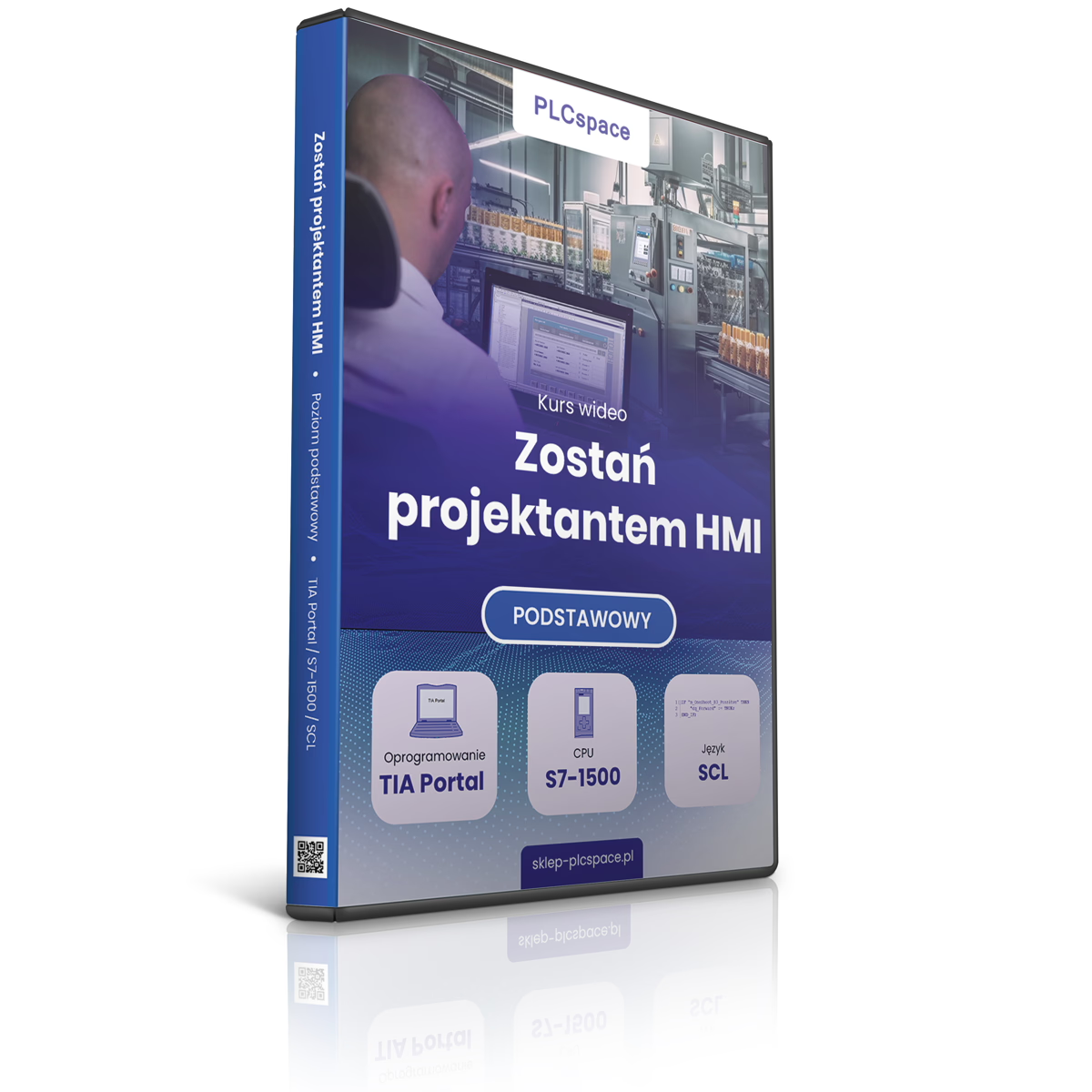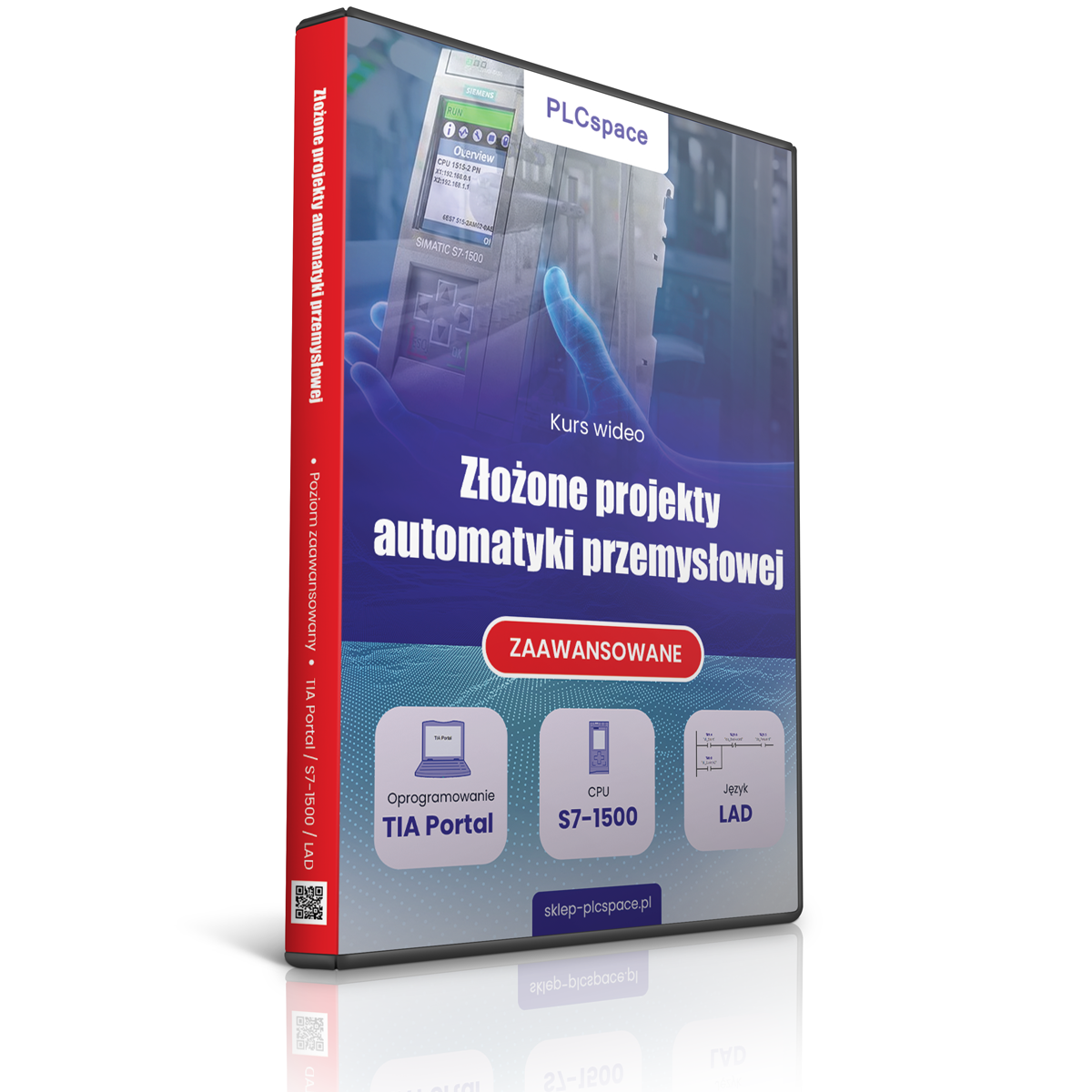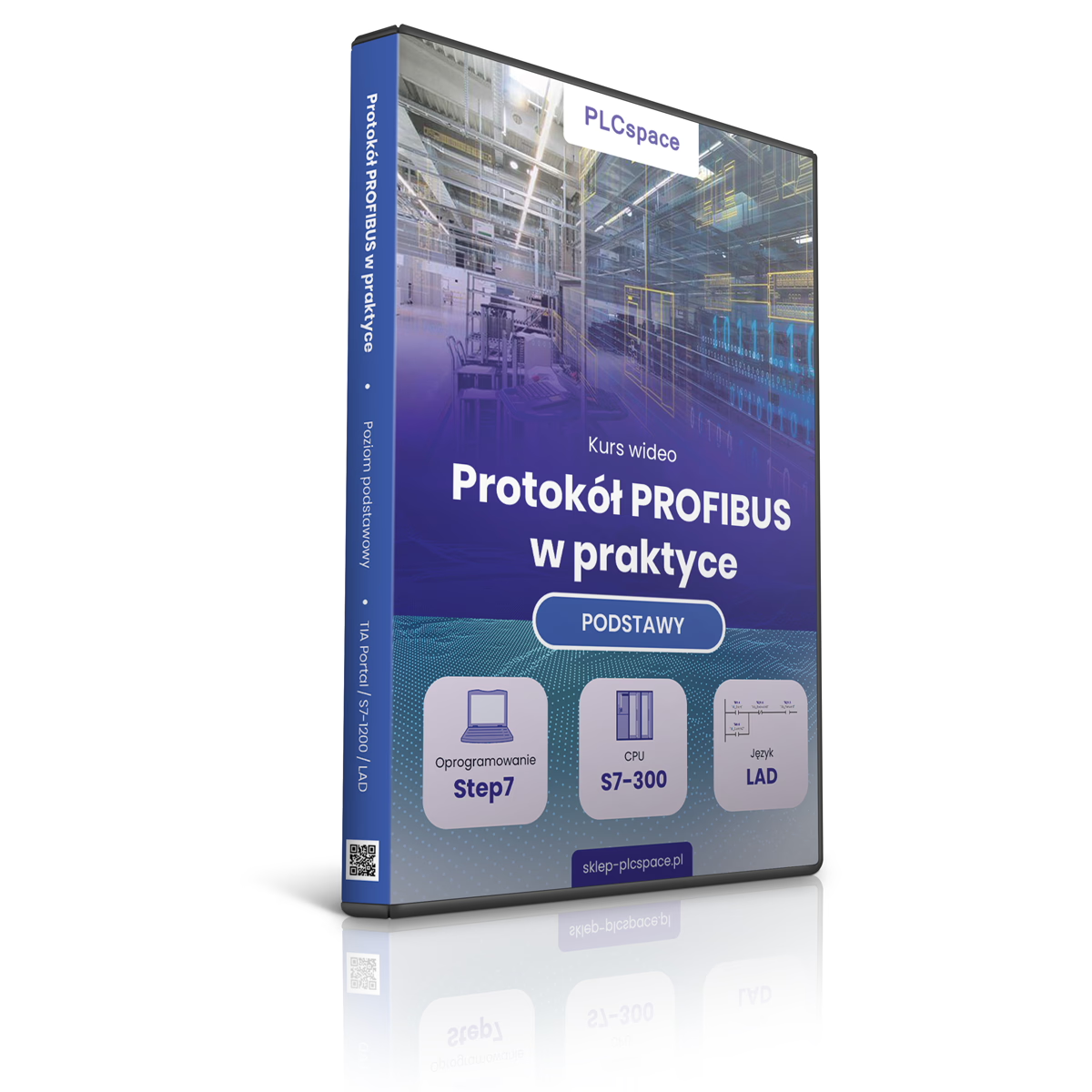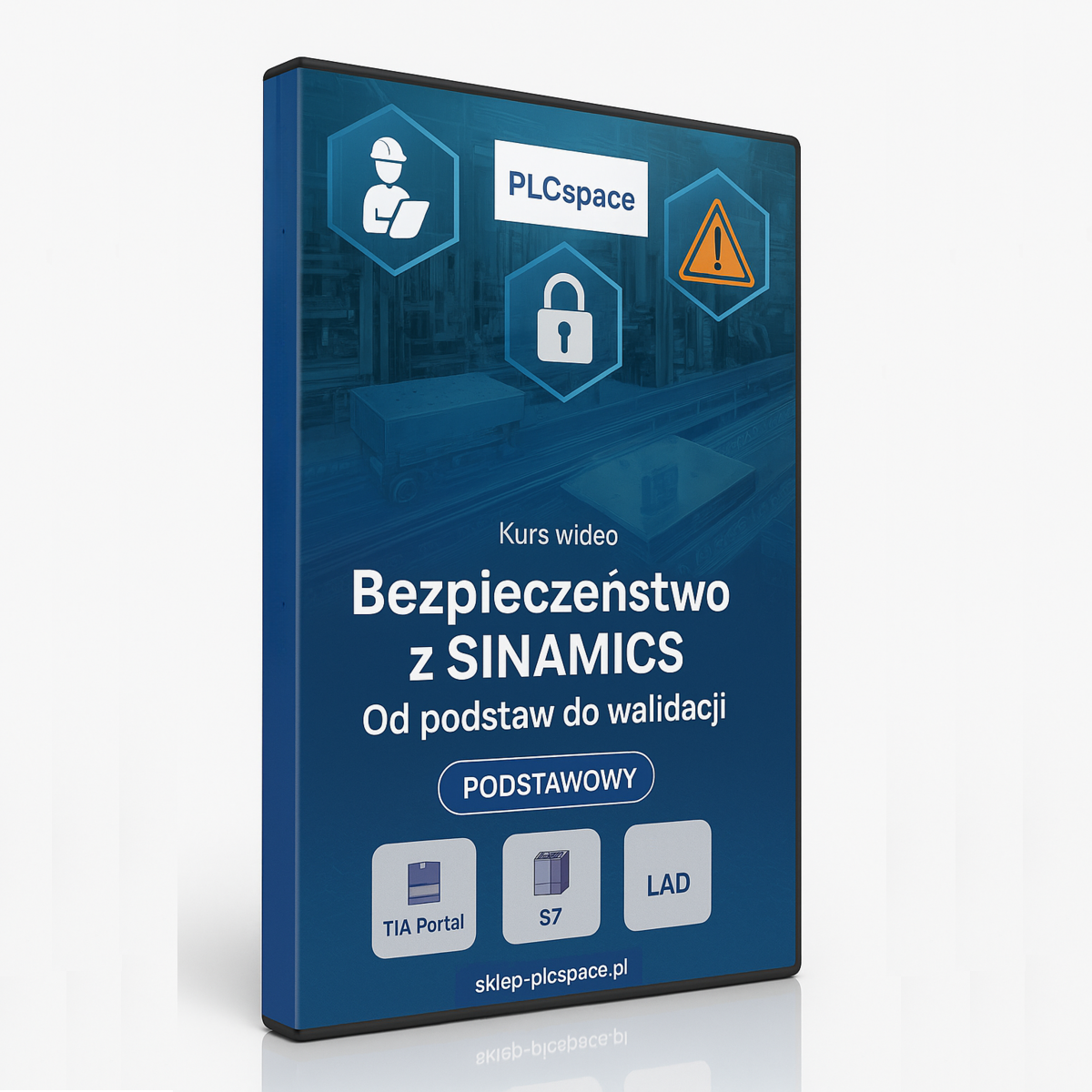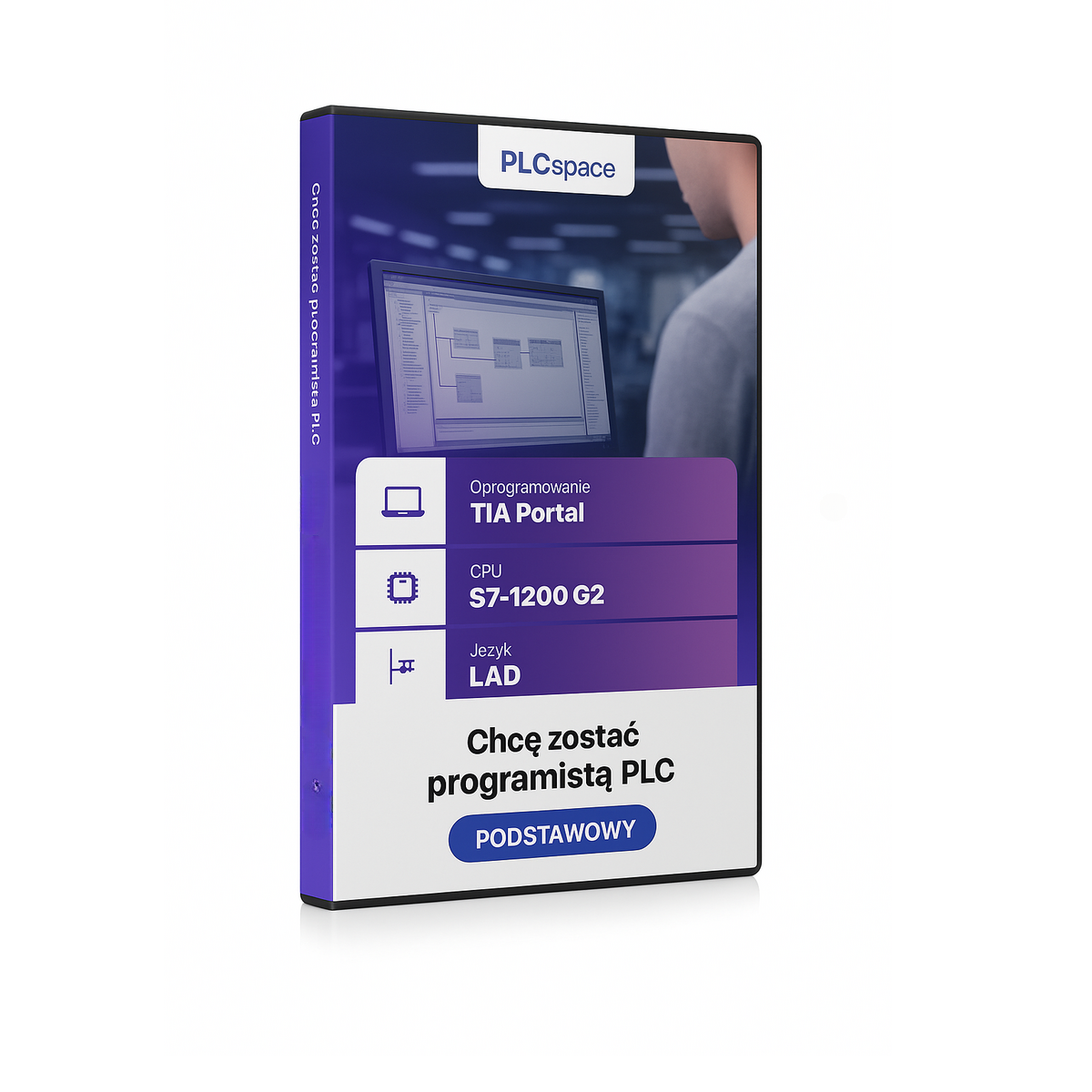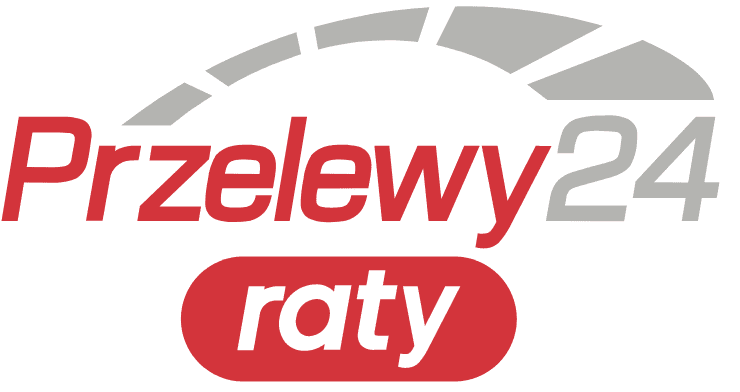Become an HMI designer
- Level:
The development environment used in the course
- Software:
Core unit family used in the course
- CPU:
A set of rules that are used to develop programme code
- Language:
Frequency converter (inverter) family used in the course
- Drive
228.77 €
Co otrzymasz po zapisaniu się na kurs wizualizacji paneli HMI ?
Kurs Projektowania HMI Panelu KPT400 pod tytułem „Zostań Projektantem HMI” przewiedzie Cię przez podstawowe zagadnienia tworzenia oprogramowania, likwidując nadmiar zawiłych pojęć i wytycznych programistycznych. Wybierając tę ofertę, dostaniesz:
Zostań Projektantem HMI – kurs wizualizacji HMI z panelem KPT400
W naszym płatnym kursie wizualizacji HMI panelu KPT400 o nazwie 'Zostań Projektantem HMI’ odkryjesz intrygujący świat automatyzacji przemysłowej. Poznasz elementy wizualizacji, obiekty graficzne. Nasza oferta edukacyjna skupia się na praktycznych aspektach, ucząc poprzez realizację realistycznych funkcji w aplikacjach przemysłowych.
Zapewniamy dostęp do 90 lekcji wideo w jakości Full HD, co stanowi ponad 25 godzin materiałów. Tematy zostały starannie ułożone, tworząc spójny ciąg logiczny, który poprowadzi Cię przez świat projektowania wizualizacji na panele Basic z rodziny SIMATIC firmy Siemens. Każda lekcja to krok naprzód w Twoim rozwoju.
Ta oferta edukacyjna opiera się na praktyce. Skorzystamy również z programu TIA Portal oraz symulatora paneli HMI, lub jeśli masz dostęp do rzeczywistego sprzętu, możesz pracować na nim.
Po zakończeniu kursu będziesz pewnie konfigurować panele HMI basic i przygotowywać wizualizacje. Zdobędziesz wiedzę nie tylko teoretyczną, ale przede wszystkim praktyczną, która pomoże Ci stawić czoła rzeczywistym wyzwaniom w automatyce przemysłowej.
Dołącz do naszego kursu, aby poznać pełny potencjał podstawowych paneli HMI. Już teraz możesz zdobyć praktyczne umiejętności potrzebne w świecie automatyki przemysłowej.
Knowledge test:
Is this course for you? Take this test MULTIPLE choice to check it out.
Key information about the course
Of course! You have access without time and place restrictions
For many people, going away for a few days and the pressure of a group is not the ideal start. This is why many start with a video course, only to later decide on a residential course.
To szkolenie zostało stworzone w taki sposób, aby wykorzystać zasoby, jakie uczestnik ma aktualnie. Zajęcia obejmują zagadnienia z elektryki, podłączeń i schematów, a także porównują rzeczywisty panel HMI do wirtualnego. To istotne, gdyż automatycy często korzystają z symulatora HMI lub rzeczywistego panelu w zależności od sytuacji i dostępnego sprzętu
Otrzymasz doświadczenie podobne do obserwowania mojej pracy na żywo, przy mnie i ze szczegółowym wyjaśnieniem. W efekcie zobaczysz rezultaty prac w postaci określonych funkcjonalności na panelu HMI.
W trakcie nauki i poznawania sprzętu oraz obiektów graficznych, pełna funkcjonalność licencji testowej (trial) w zupełności wystarczy. Przedstawię Ci, jak wykorzystać tę opcję w celu ukończenia kursu przy użyciu TIA Portal.
Kluczowe jest, aby nasza praca była czytelna i zrozumiała, nawet kiedy po pewnym czasie wrócisz do projektu. Oprócz nauki procesów związanych z automatyką i projektowaniem wizualizacji, będę kłaść nacisk na kształtowanie u Ciebie solidnych praktyk zgodnych z zasadami obowiązującymi w świecie automatyki przemysłowej.
Aby solidnie utrwalić zdobytą wiedzę, kluczowe są trening i ćwiczenia. W związku z tym, otrzymasz prace domowe. Rozwiązywanie zadań i problemów to najszybsza ścieżka do opanowania umiejętności.
Benefits of taking part in the course
Example lesson
Jak wygląda kurs z wizualizacji dla paneli HMI?
Po zapisaniu się na kurs, otrzymasz wiadomość e-mail zawierającą dane do logowania do naszej platformy edukacyjnej. Tam będziesz mieć dostęp do kompletnego zestawu materiałów oraz lekcji, podzielonych na klarowne sekcje zgodnie z treścią kursu. To pozwoli Ci na swobodne śledzenie kursu w tempie dostosowanym do Twoich potrzeb. Niezależnie od tego, czy korzystasz z komputera czy telefonu komórkowego, z łatwością uzyskasz dostęp do wszystkich treści. Po ukończeniu każdej lekcji, oznaczysz ją jako zakończoną, aby zawsze mieć pełny obraz swojego postępu.
-
Module 1 - downloading and installing the TIA Portal environment
- Lesson 1 - Registration on the Siemens website
- Lesson 2 - Which files to download
- Lesson 3 - Installation of the TIA Portal software
- Lesson 4 - Installing the PLCsim simulator
-
Module 2 - Downloading and installing the virtual factory - Factory IO
- Lesson 1 - Which files to download
- Lesson 2 - Installation of the Factory IO tool
-
Module 3 - Licences
- Lesson 1 - TIA Portal - Activation of a TRIAL licence
- Lesson 2 - TIA Portal - Activating the full licence (floating)
- Lesson 3 - Factory IO- Activation of TRIAL licences
- Lesson 4 - Factory IO - Activating the full licence
-
Module 4 - Actual PLC
- Lesson 1 - Electrical Engineering - Diagram
- Lesson 2 - Preparing the PC/PG
- Lesson 3 - Searching for PLCs on an Ethernet/PROFINET network
- Lesson 4 - Adapting the PLC for the course
-
Moduł 1: Opcje ogólne
- Lekcja 1 – Preferencje globalne dla środowiska WinCC TIA
- Lekcja 2 – Wyświetlanie szablonu podczas redagowania ekranu
- Lekcja 3 – Proporcje obiektów ekranowych podczas transformacji
- Lekcja 4 – Inne ustawienia ogólne w środowisku WinCC TIA Portal
- Lekcja 5 – Zadanie „Transformacja typu panelu”
- Lekcja 6 – Inicjacja zmiany typu panelu
- Lekcja 7 – Raporty z transformacji oraz kompilacji
- Lekcja 8 – Opcje globalne dla projektu wizualizacji
- Lekcja 9 – Języki i czcionki instalowane na panelu
-
Moduł 2: Założenie projektu
- Lekcja 1 – Tworzenie nowego projektu
- Lekcja 2 – Selekcja CPU – Nieokreślona
- Lekcja 3 – Wejście w TIA Portal – początkowy ekran
- Lekcja 4 – Pobieranie ustawień z przypisanego CPU
- Lekcja 5 – Rozpoznanie dostępnych w sieci urządzeń
- Lekcja 6 – Kontrola lub zmiana adresu IP odczytanego z kontrolera
- Lekcja 7 – Zapis i import konfiguracji do PLC z podmianą adresu IP
- Lekcja 8 – Tworzenie bloku danych
- Lekcja 9 – Deklaracja zmiennych w bloku danych
- Lekcja 10 – Wprowadzanie kodu
- Lekcja 11 – Przypisywanie zmiennych
- Lekcja 12 – Ustanowienie sieci PROFINET w widoku sieci
- Lekcja 13 – Modyfikacja bloku programowego
- Lekcja 14 – Inspekcja bloku programowego
- Lekcja 15 – Testowanie aplikacji
- Lekcja 16 – Wybór panelu operatorskiego w planie
- Lekcja 17 – Konfiguracja adresu urządzenia w sieci PROFINET
- Lekcja 18 – Rozbudowa edytora ekranów wizualizacji
- Lekcja 19 – Dodawanie pola z daną procesową
- Lekcja 20 – Ustanowienie nowego połączenia HMI
- Lekcja 21 – Poprawne skonfigurowane połączenie HMI
- Lekcja 22 – Wstawianie tekstu statycznego
- Lekcja 23 – Kreacja zmiennej HMI na bazie zmiennej z PLC
- Lekcja 24 – Kompilacja i weryfikacja w symulatorze Runtime
- Lekcja 25 – Konieczne ustawienia S7ONLINE dla aplikacji Runtime
- Lekcja 26 – Przygotowanie panelu do pierwszego użytku
- Lekcja 27 – Ustawienie portu ETHERNET w panelu
- Lekcja 28 – Przesłanie konfiguracji na panel
- Lekcja 29 – Dodanie przycisku na ekranie
- Lekcja 30 – Wezwanie konfiguratora sieci
- Lekcja 31 – Zapis i odczyt projektu
-
Moduł 3: Projektowania interfejsów wizualizacyjnych
- Lekcja 1 – Zmiana jednostki „Nieokreślony CPU” na rzeczywisty
- Lekcja 2 – Nadzór nad blokiem DB zawierającym dane procesowe
- Lekcja 3 – Inicjowanie nowego projektu wizualizacyjnego z pomocą kreatora
- Lekcja 4 – Instrukcja kreatora –
- Lekcja 5 – Modyfikacja ustawień
- Lekcja 6 – Instrukcja kreatora –
- Lekcja 7 – Korekcja adresów IP sterownika i panelu
- Lekcja 8 – Wykorzystanie ekranu globalnego
- Lekcja 9 – Implementacja szablonów ekranów wizualizacyjnych
- Lekcja 10 – Realizacja projektu wizualizacji przy użyciu szablonu
-
Moduł 1 - Fundamentalne elementy ekranowe
- Lekcja 1 – Charakterystyka ekranu
- Lekcja 2 – Właściwości ekranu
- Lekcja 3 – Ekrany widoczne i niewidoczne, zdarzenia
- Lekcja 4 – Obiekty zaznaczone
- Lekcja 5 – Uzyskanie dostępu do okna właściwości danego elementu
- Lekcja 6 – Linia – cechy szczególne elementu
- Lekcja 7 – Wielokąt – cechy szczególne elementu
- Lekcja 8 – Wytwarzanie własnej grafiki do użytku w TIA Portal
-
Moduł 2 - Zmienne i pola
- Lekcja 1 – Zmienne w HMI
- Lekcja 2 – Konstruowanie zmiennej HMI wraz z obiektem ekranowym
- Lekcja 3 – Konsola zmiennych HMI
- Lekcja 4 – Tworzenie zmiennej w konsoli
- Lekcja 5 – Atrybuty zmiennej HMI
- Lekcja 6 – Proporcjonalne skalowanie
- Lekcja 7 – Próba „Regulacji zmiennej o punktowym adresowaniu”
- Lekcja 8 – Limity wartości i ich oddziaływanie
- Lekcja 9 – Kreacja i eksploatacja wewnętrznych zmiennych
- Lekcja 10 – Eksport i import danych do pliku .xlsx
- Lekcja 11 – Właściwości pól ekranowych
- Lekcja 12 – Formatowanie wartości liczbowych w polach
- Lekcja 13 – Ramka pola, tło i styl tekstu
- Lekcja 14 – Wskazanie przekroczenia limitów wartości
- Lekcja 15 – Pozostałe cechy pola
-
Moduł 3 - Pomocnicze treści
- Lekcja 1 – Statyczne przypisanie tekstu pomocniczego do przycisku ekranowego
- Lekcja 2 – Wzywanie kontekstowych tekstów pomocniczych
- Lekcja 3 – Opcje tworzenia tekstu pomocniczego
-
Moduł 1: Animacja składników ekranowych
- Lekcja 1 – Skupienie obiektów
- Lekcja 2 – Sterowanie barwami i pulsacją
- Lekcja 3 – Techniki kontroli barw i pulsacji
- Lekcja 4 – Sterowanie widzialnością elementu
- Lekcja 5 – Manipulacja lokalizacją
- Lekcja 6 – Zmienność w położeniu
- Lekcja 7 – Zręczne przemieszczanie elementu
- Lekcja 8 – Przemieszczanie w poziomie
- Lekcja 9 – Przemieszczanie w pionie
- Lekcja 10 – Bank symboli
- Lekcja 11 – Korekta symboli
-
Moduł 2: - Przyciski, klawisze i przełączniki
- Lekcja 1 – Charakterystyka przycisków, różnorodność typów
- Lekcja 2 – Konfiguracja przycisku tekstowego
- Lekcja 3 – Przyciski, manipulacja kolorem tekstu i tła
- Lekcja 4 – Przyciski, regulacja atrybutów tekstu
- Lekcja 5 – Wizualne efekty trójwymiarowych przycisków
- Lekcja 6 – Konfiguracja szczegółowych parametrów przycisków
- Lekcja 7 – Ustalanie ograniczeń dostępu dla przycisków
- Lekcja 8 – Mapowanie funkcji na przyciski
- Lekcja 9 – Konfiguracja przycisku – ukrywanie
- Lekcja 10 – Konfiguracja graficznego przycisku
- Lekcja 11 – Kreowanie własnych grafik
- Lekcja 12 – Wprowadzanie grafiki z pliku
- Lekcja 13 – Dodawanie obiektu z globalnego repozytorium
- Lekcja 14 – Globalny ekran, szablony oraz ekrany użytkownika
- Lekcja 15 – Klawisze funkcyjne, przydzielenie grafiki
- Lekcja 16 – Klawisze funkcyjne, przydzielenie grafiki oraz funkcji
- Lekcja 17 – Klawisze funkcyjne, wiązanie zdarzenia
- Lekcja 18 – Właściwości przełącznika
- Lekcja 19 – Parametry przełącznika
-
Moduł 3: - Listy tekstowe i graficzne
- Lekcja 1 – Rola list tekstowych w interfejsach użytkownika
- Lekcja 2 – Tworzenie i różnorodność list tekstowych
- Lekcja 3 – Tworzenie obiektu listy tekstowej
- Lekcja 4 – Wprowadzenie listy tekstowej binarnej
- Lekcja 5 – Operacje na listach binarnych
- Lekcja 6 – Listy tekstowe numeryczne
- Lekcja 7 – Instrukcja „Tworzenie listy graficznej”
- Lekcja 8 – Generowanie graficznej listy danych
- Lekcja 9 – Kształtowanie osadzonego obiektu graficznego OLE
- Lekcja 10 – Konfiguracja ekranowego obiektu listy graficznej
- Lekcja 11 – Aspekty wymiarowe i kolorystyczne obiektu listy graficznej
- Lekcja 12 – Lista dwustanowa z grafikami
- Lekcja 13 – Opis przycisku ekranowego za pomocą listy graficznej
- Lekcja 14 – Wykorzystanie obiektów bibliotecznych z listami graficznymi
-
Moduł 1 - Projekty wielojęzyczne
- Lekcja 1 – Warianty językowe projektów
- Lekcja 2 – Dodawanie nowego języka do projektu
- Lekcja 3 – Języki dostępne podczas działania w trybie Runtime
- Lekcja 4 – Selekcja fontów używanych do opisów
- Lekcja 5 – Język interfejsu, język odniesienia
- Lekcja 6 – Wykorzystanie języka odniesienia podczas translacji
- Lekcja 7 – Użycie klawiatury na ekranie
- Lekcja 8 – Skorzystanie z tablicy tekstów – praktyczny sposób na edycję opisów
- Lekcja 9 – Eksport plików z tekstem projektu
- Lekcja 10 – Import plików z tekstem projektu
- Lekcja 11 – Modyfikacja języka w trybie online
- Lekcja 12 – Zalety wynikające z implementacji różnych wersji językowych
- Lekcja 13 – Proces tworzenia projektu wielojęzycznego
-
Moduł 2 - Komunikaty
- Lekcja 1 – Implementacja systemu powiadamiania
- Lekcja 2 – Kategorie komunikatów
- Lekcja 3 – Konfiguracja kategorii komunikatów
- Lekcja 4 – Typy alarmów
- Lekcja 5 – Inicjowanie komunikatów
- Lekcja 6 – Kształtowanie alarmów dyskretnych
- Lekcja 7 – Prezentacja wartości zmiennych w treści alarmów
- Lekcja 8 – Atuty alarmów dyskretnych
- Lekcja 9 – Schemat potwierdzania alarmów
- Lekcja 10 – Grupy potwierdzania komunikatów
- Lekcja 11 – Opis pomocy związany z alarmem
- Lekcja 12 – Przypisanie operacji do alarmów
- Lekcja 13 – Pokazywanie alarmów w projekcie utworzonym przy pomocy kreatora
- Lekcja 14 – Globalne konfiguracje modułu komunikatów
- Lekcja 15 – Obiekty na globalnym ekranie skojarzone z systemem alarmowym
- Lekcja 16 – Istotne właściwości obiektu „Wskaźnik alarmu”
- Lekcja 17 – Kluczowe parametry obiektu „Okno alarmowe”
- Lekcja 18 – Istotne cechy obiektu „Okno alarmowe”
- Lekcja 19 – Główne parametry obiektu „Okno alarmowe”
- Lekcja 20 – Spis alarmów na ekranie użytkownika: „Widok alarmów”
- Lekcja 21 – Znaczące właściwości obiektu „Widok alarmów”
- Lekcja 24 – Kreator alarmów analogowych
- Lekcja 25 – Kluczowe parametry alarmu analogowego
-
Moduł 3 - Użytkownicy i hasła
- Lekcja 1 – Funkcjonowanie systemu zabezpieczeń
- Lekcja 2 – Grupowanie użytkowników
- Lekcja 3 – Dane osobowe użytkowników
- Lekcja 4 – Konfiguracja zabezpieczeń systemu
- Lekcja 5 – Zablokowanie dostępu do elementów ekranowych
- Lekcja 6 – Ograniczenie dostępu do klawiszy funkcjonalnych
- Lekcja 7 – Redagowanie parametrów użytkowników w trybie Runtime
- Lekcja 8 – Wykorzystanie funkcji bibliotecznych związanych z systemem zabezpieczeń
-
Module 1 - TIA Portal
- Lesson 1 - Integration of engineering software
- Lesson 2 - Centralised engineering structure
- Lesson 3 - Intuitive - efficient - future-oriented
- Lesson 4 - Efficient engineering for beginners
- Lesson 5 - Compatibility and high level of protection
- Lesson 6 - Intuitive user interface
- Lesson 7 - Emphasis on tasks and users
- Lesson 8 - Task-oriented navigation
- Lesson 9 - Attractive user interface
- Lesson 10 - Identical layout in all editors
- Lesson 11 - SCADA - now simplified
- Lesson 12 - Visualising the process
- Lesson 13 - Safety
- Lesson 14 - Integrating safety
- Lesson 15 - Efficient engineering for beginners
- Lesson 16 - Devices and networks
- Lesson 17 - A "clean" layout for an efficient configuration
- Lesson 18 - A well-organised view of the web
- Lesson 19 - Aggregated data
- Lesson 20 - Easy handling of big data
- Lesson 21 - Collaborative data management
- Lesson 22 - High quality design
- Lesson 23 - Programming
- Lesson 24 - Efficient programming for fast and flexible solutions
- Lesson 25 - Intuitive graphic programming techniques
- Lesson 26 - Intuitive programming in a high-level language
- Lesson 27 - Controller and HMI interaction (1/2))
- Lesson 28 - Controller and HMI interaction (2/2)
- Lesson 29 - Library concept
- Lesson 30 - Cost optimisation and re-use of know-how
- Lesson 31 - System diagnostics
- Lesson 32 - Easy monitoring of installations and components in the program
- Lesson 33 - Accessing the current status of the system at any time
- Lesson 34 - Compatibility and high level of investment protection
- Lesson 35 - Scalability
- Lesson 36 - Comprehensive engineering for all SIMATIC S7 controllers
- Lesson 37 - Complex engineering from panel to SCADA
- Lesson 38 - Password protection
- Lesson 39 - Protection against unauthorised access
Software and hardware used
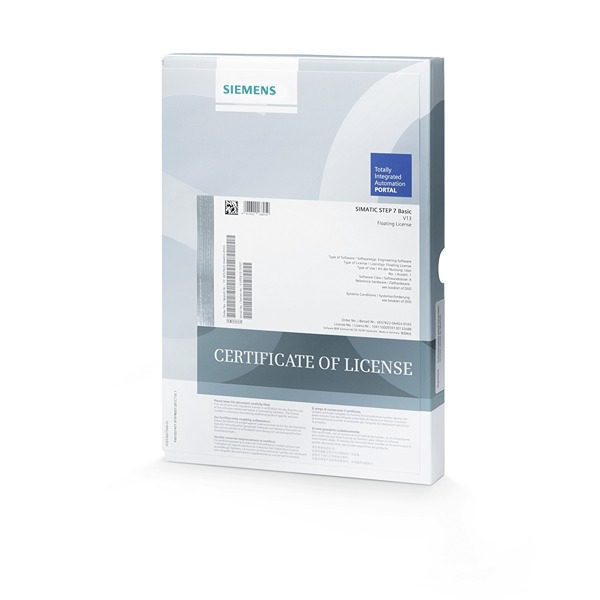
TIA Portal software
Totally integrated automation is a development environment that combines PLC (programming), HMI(visualisation) and startdrive(drive technology).
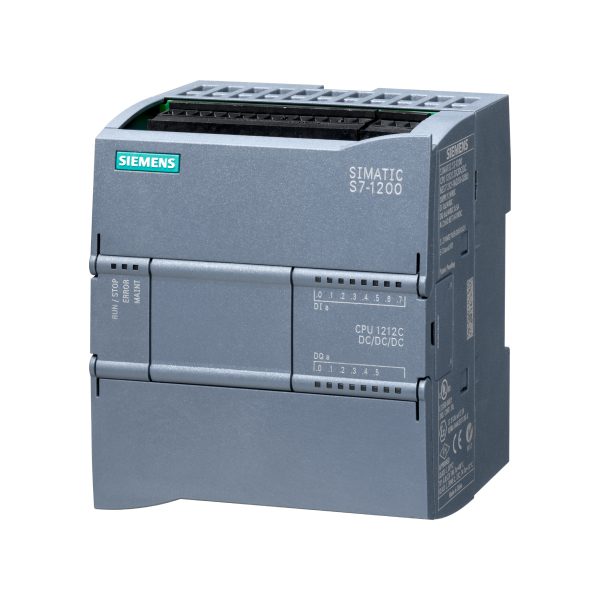
CPU S7-1200
The new controller, which has been developed as a successor to the S7-200, is characterised by slightly weaker parameters than the S7-300 family. Several CPU versions present in the family allow selection according to project requirements.
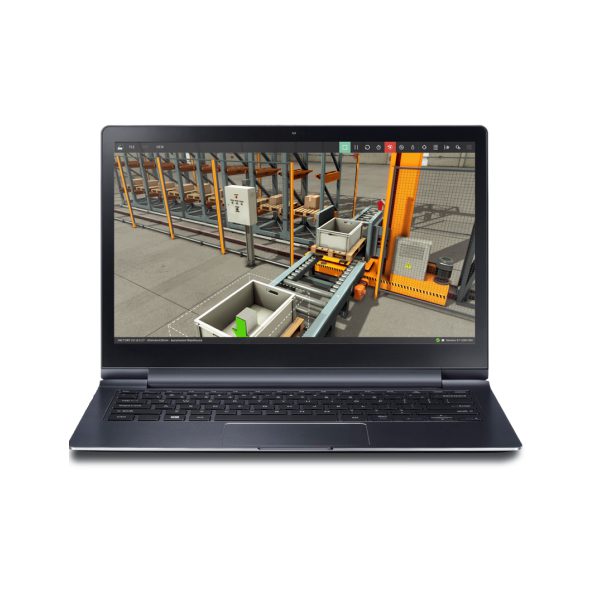
Factory IO
Typical machine scenarios can be run in Factory IO, and the virtual factory connects to the SIM PLC simulator (or the actual PLC. Programming of the controller is possible in the programming environment (depending on the PLC family), and insight into its operation is available during the online connection
What will you be able to do after completing the course?
Zakończenie technicznej szkoły to znaczący sukces, jednak co dalej z takim osiągnięciem? Jeśli rozważałeś studia, rozważ tę opcję. Nasza oferta edukacyjna stanowi szybki skok naprzód w Twojej ścieżce zawodowej. Otrzymasz zaświadczenie, które od razu będzie przynosić korzyści. Tworzenie wizualizacji na panele HMI firmy Siemens otwiera wiele możliwości. Po ukończeniu naszego kursu będziesz miał elastyczność w zmianie branż i stanowisk – to zależy od Ciebie, w której dziedzinie chcesz się specjalizować
Po ukończeniu tego kursu projektowania wizualizacji będziesz gotowy do rozpoczęcia fascynującej kariery w automatyce przemysłowej. Od programisty PLC po inżyniera sprzedaży, od technicznego specjalisty po product managera – otwierają się przed Tobą różnorodne ścieżki zawodowe. Twoje zdobyte umiejętności pozwolą Ci efektywnie zarządzać projektami, tworzyć interfejsy graficzne i realizować innowacyjne rozwiązania, przyczyniając się do sukcesu w dynamicznym środowisku przemysłu
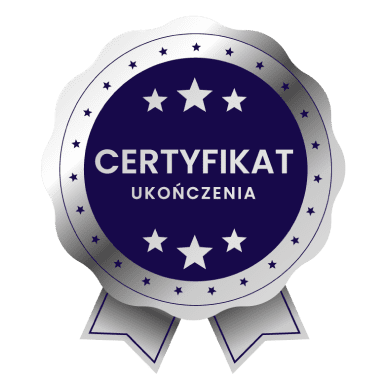

Guarantee
and certificate
If, after 14 days of purchase, you find that it is not for you, I will refund 100% of the course price. Upon completion of the course, you will receive a certificate in two languages - Polish and English.

Frequently asked questions
-
Will I receive a confirmation after my purchase?
Yes, you receive an email. Sometimes emails end up in SPAM or other folders. Please check your mailbox carefully.
-
Is there a difference between the media on which the course can be ordered?
No. The material is the same regardless of the type of storage medium. At the time of purchase, you decide which type of data carrier you choose, i.e. online or USB.
-
Jaki panel HMI wybrać na początku?
Prosty z najważniejszymi funkcjonalnościami. Do podstawowych funkcjonalności będzie dobry KP300 lub KTP400.
-
Czy ten kurs jest dla mnie, jeżeli nigdy nie używałem HMI?
Tak. Kursy podstawowe są właśnie przygotowane w taki sposób, aby osoby bez styczności z HMI firmy Siemens mogły nauczyć się takich umiejętności. Kursant jest prowadzony krok po kroku (co widać też w spisie treści kursu).
-
Can I deliver the course on different computers?
Yes. The course material (videos) can be viewed on any computer.
-
What does the online version of the course look like?
Dostęp do kurs otrzymują Państwo na maila, gdzie jest link do zalogowania na platformę e-learningowa.
-
What if a problem arises during the course?
Please email me with a description of the problem at: biuro@plcspace.pl.
-
What is the access time for the course?
Bez ograniczeń czasowych dla każdego nośnika (czyli wersji online lub USB).
-
Czy muszę mieć jakiekolwiek doświadczenie z projektowaniem HMI?
No. The basic course gives step-by-step all the information needed from 'scratch'.
-
Will I need to purchase a licence for the Factory IO software?
No. There is information in the course on how to obtain licences to complete the material.
-
Will I need to purchase a licence for the PLC development environment?
No. There is information in the course on how to obtain licences to complete the material.
-
Is it possible to return the course?
Yes.
-
Will I need a PLC to deliver the course?
Nie. Sterownik rzeczywisty nie jest konieczny. Kurs jest przygotowany w taki sposób, że można go zrealizować także na sterowniku wirtualny (czyli PLCsim). Wszystko zależy od tego, czym dysponuje kursant.
-
How do I buy a course?
Just click Add to basket and complete the form and make payment.
-
When does the course start?
-> Online version - immediately after payment
-> Physical version - when you receive the package from the carrier.
Buy as a set and save
Select at least 2 courses from the list and the first free book item (three selections in total) and an automatic discount of 25% will be calculated in your basket.
If you want to find out more about a particular course, click on its name and the page will take you to its offerings.
Companies that have benefited from our courses




































Feedback from students
 Stanislaw
Stanislaw
What sets this course apart is the opportunity to acquire practical, concrete knowledge. Everything is clearly explained. Definitely recommended!
 Marcel
Marcel
After going through the course, I know what the components of the programming environment are and what to do step by step. Now I feel confident and know what I am doing
 Leon
Leon
Course delivered in a very accessible way. Contains a lot of interesting and useful information.
 Michael
Michael
I can honestly recommend the course. It is solid and factual knowledge. I will definitely be buying more.
 Victor
Victor
Thanks to the course, I have decided to go further in this direction. The goal is to look for a more challenging and better job
 Peter
Peter
The course prepared by Mr Tomasz is distinguished by its high level of content and meticulously prepared lessons. They are planned in a clear and sensible manner, making it easier to assimilate knowledge and return to the material if necessary. An additional advantage is the possibility of a free consultation.
 Nikodem
Nikodem
Definitely recommended! The facts themselves, no unnecessary dwelling on issues.
 Ignatius
Ignatius
This is my first course, certainly not my last. I am impressed with the substantive quality of the knowledge.
 Tymon
Tymon
Everything clearly explained, you can really learn a lot. Lots of practical information and examples to help you remember everything. In my opinion, it is worth using this form of learning because you can learn anytime and anywhere. It is practical and convenient.
You may also be interested in:
- Level:
The development environment used in the course
- Software:
Core unit family used in the course
- CPU:
A set of rules that are used to develop programme code
- Language:
Frequency converter (inverter) family used in the course
- Drive
274.57 €
- Level:
The development environment used in the course
- Software:
Core unit family used in the course
- CPU:
A set of rules that are used to develop programme code
- Language:
Frequency converter (inverter) family used in the course
- Drive
228.77 €
- Level:
The development environment used in the course
- Software:
Core unit family used in the course
- CPU:
A set of rules that are used to develop programme code
- Language:
Frequency converter (inverter) family used in the course
- Drive
228.77 €
- Level:
The development environment used in the course
- Software:
Core unit family used in the course
- CPU:
A set of rules that are used to develop programme code
- Language:
Frequency converter (inverter) family used in the course
- Drive
274.57 €
